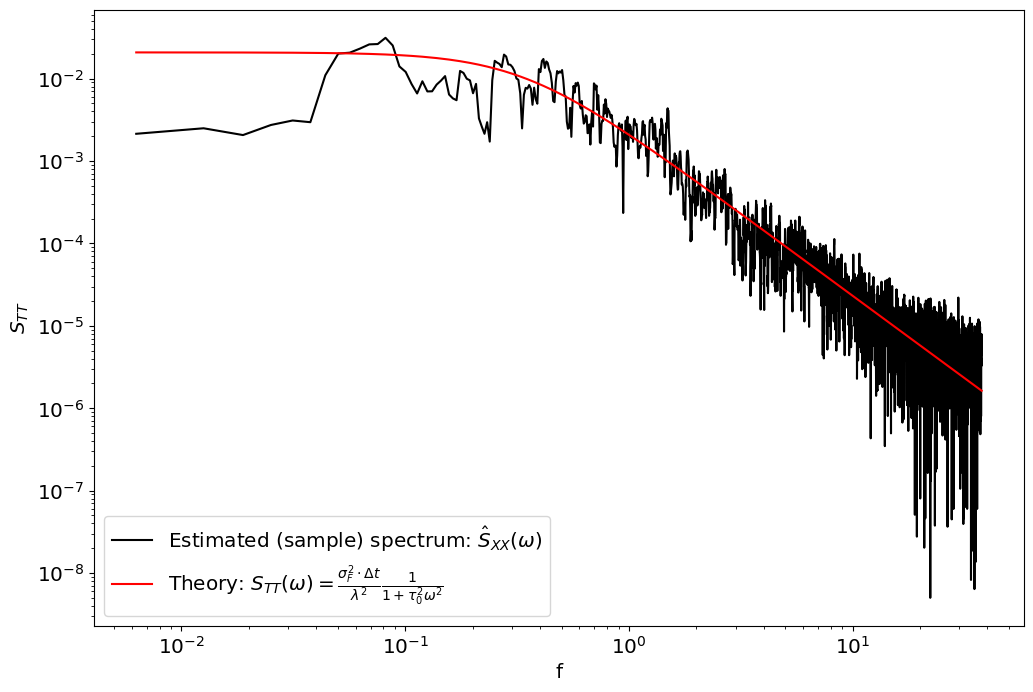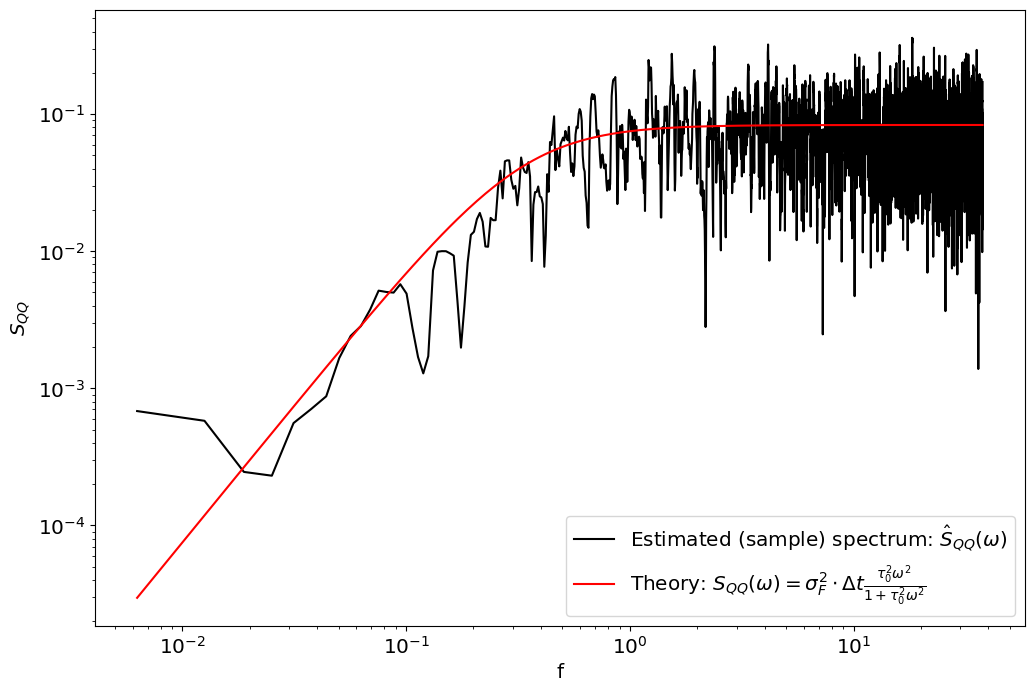4. Theoretical Solutions#
Show code cell source
import numpy as np
import matplotlib.pyplot as plt
from scipy import stats
if 'google.colab' in str(get_ipython()):
print('Running on CoLab, need to install multitaper')
%pip install multitaper
from multitaper import mtspec
from multitaper import mtcross
params = {'legend.fontsize': 'x-large',
'figure.figsize': (12, 8),
'axes.labelsize': 'x-large',
'axes.titlesize':'x-large',
'xtick.labelsize':'x-large',
'ytick.labelsize':'x-large'}
plt.rcParams.update(params)
We now have everythign in place to theoretically compute the spectrum of Hasselmann-type models.
Power Spectrum of the standard Hasselmann Model.#
Let’s first solve for the theoretical spectrum of a Hasselmann model, and compare it with a simulation of the Hasselmann model using a time-step \(\Delta t\). Remember, the Hasselmann model is
where \(F\) is white noise (at least at frequencies lower than the sampling frequency \(\left|f\right|<f_{N}=1/\left(2\Delta t\right)\)).
The power spectrum of the Hasselmann model can be solved for by taking the Fourier transform of the differential equation:
The spectrum can be computed as:
Using the fact that a white-noise process has a constant spectral variance density:
we can write the spectrum of a Hasselmann model forced with white noise as:
If we want to check this spectrum against a numerical simulation where we used a time-step of \(\Delta t\) and set a variance \(\sigma_{F}\) for the forcing vector \(F_{n}\), we can write:
Writing it in this way is also useful if, say, we want to model the spectrum of monthly surface temperatures as a function of the variance of monthly variations in surface heat flux forcing
plt.figure(figsize=[12,8])
#physical parameters:
sigma_F=1;
tau=3;
l=2;
C=tau*l;
# numerical parameters
dt=1/12
T=500
#compute other required variables
t=np.arange(0,T,dt)
N=len(t)
phi=1-(dt*l/C);
#white noise forcing
F=stats.norm.rvs(loc=0,scale=sigma_F,size=N)
eps=F*dt/C
#integrate
T=np.zeros(N)
for j in range(1,N):
T[j]=phi*T[j-1]+eps[j]
#compute spectrum
out=mtspec.MTSpec(T,nw=2,dt=dt,kspec=3)
f=out.freq
S_TT=out.spec
S_TT=S_TT[f>0]
f=f[f>0]
#theory
S_TT_theory=sigma_F**2*dt/(l**2) * 1/(1+(tau**2)*(2*np.pi*f)**2)
#plot
plt.plot(2*np.pi*f,S_TT,'k',label=r'Estimated (sample) spectrum: $\hat S_{XX}(\omega)$')
plt.plot(2*np.pi*f,S_TT_theory,'r',label=r'Theory: $S_{TT}(\omega)=\frac{\sigma_{F}^{2}\cdot\Delta t}{\lambda^{2}}\frac{1}{1+\tau_{0}^{2}\omega^{2}}$')
plt.xscale('log')
plt.yscale('log')
plt.legend()
plt.xlabel(r'f')
plt.ylabel(r'$S_{TT}$')
Text(0, 0.5, '$S_{TT}$')

Asymptotic behaviour#
In the limit of high frequencies (short time-scales): \(\omega\gg\tau_{0}\). i.e. \(f\gg\frac{1}{2\pi\tau_{0}}\) the dominant balance in the denominator becomes \(\omega^{2}\tau_{0}^{2}\gg1\) and the power spectrum asymptomes to \(S_{TT}\sim\frac{\tilde{s}_{F}^{2}}{\lambda^{2}\tau_{0}^{2}}\frac{1}{\omega^{2}}\) which obbeys a power law scaling of \(S_{TT}\sim f^{-2}\) or \(\omega^{-2}\).
In the limit of low frequencies (long time-scales): \(\omega\ll\tau_{0}\). i.e. \(f\ll\frac{1}{2\pi\tau_{0}}\) , the dominant balance is reversed, with \(1\gg\omega\tau_{0}^{2}\) and the spectrum asymptotes to: \(S_{TT}\left(\omega\right)\sim\frac{\tilde{s}_{F}^{2}}{\lambda^{2}\tau_{0}^{2}}\)
As you can see from the figure above there are essentially two pieces of information in the spectrum: the spectral density at which it tapers of, which gives us an estimate for \(\tilde{s}_{F}^{2}/\lambda^{2}\) and the characteristic time-scale \(\tau_{0}\), identifiable from the roll-off frequency. Only having information about the power-spectrum of temperature does not allow us to constrain both the variance of the forcing, \(\sigma_{F}^{2}\) \emph{and }the feedback \(\lambda\), only their ratio.
Power Spectrum of surface heat fluxes:#
In practice we may also have measurements of the net heat flux \(Q=-\lambda T+F\). The spectrum of \(Q\) will be:
Between the estimate of two spectra, \(S_{TT}\) and \(S_{QQ}\), we now have enough pieces of information to constrain all of \(\lambda,\tau_{0}\) and \(\sigma_{F}^{2}\).
#compute spectrum
Q=-l*T+F
out_Q=mtspec.MTSpec(Q,nw=2,dt=dt,kspec=3)
f=out_Q.freq
S_QQ=out_Q.spec
S_QQ=S_QQ[f>0]
f=f[f>0]
#theory
S_QQ_theory=sigma_F**2*dt * ((tau**2)*(2*np.pi*f)**2)/(1+(tau**2)*(2*np.pi*f)**2)
#plot
plt.plot(2*np.pi*f,S_QQ,'k',label=r'Estimated (sample) spectrum: $\hat S_{QQ}(\omega)$')
plt.plot(2*np.pi*f,S_QQ_theory,'r',label=r'Theory: $S_{QQ}(\omega)=\sigma_{F}^{2}\cdot\Delta t\frac{\tau_{0}^{2}\omega^{2}}{1+\tau_{0}^{2}\omega^{2}}$')
plt.xscale('log')
plt.yscale('log')
plt.legend()
plt.xlabel('f')
plt.ylabel(r'$S_{QQ}$')
Text(0, 0.5, '$S_{QQ}$')

Cross Spectrum of the standard Hasselmann Model#
We can also can estimate cross power spectral density, such as \(S_{QT}\).
The relation between two variables is also often estimated as the transfer function:
A model with two different sources of forcing:#
Now consider a Hasselmann model with two different sources of forcing and feedbacks, modelling the interaction of the mixed layer with both the atmosphere and the ocean. For starteres, let’s assume that the mixed layer temperature does not feed-back onto the ocean:
Using the linearity property of the angle bracket operator, the above equation can be written as:
Since \(F_{a}\)and \(F_{o}\) are assumed to be white noise and independent processes, \(\left\langle \tilde{F}_{a}\tilde{F}_{o}^{*}\right\rangle =\left\langle \tilde{F}_{o}\tilde{F}_{a}^{*}\right\rangle =0\), and the equation simplifies to:
With spectrum
and cross spectrum:
leading to the transfer function:
To do:#
Numerical Check#
Check the theoretical solutions for a model with two sources of forcing numerically, and fix any errors (I expect a few sign errors at the very least).
Ocean and atmospheric heat fluxes and forcing#
Compute the power spectra and cross-spectra:
as a function of parameters \(\theta=\left[C,\lambda_{a},\lambda_{o},\tilde{s}_{F_{a}},\tilde{s}_{F_{o}}\right]\) . Note that since there are two feedbacks, we can no longer define a single characteristic time-scale \(\tau_{0}\), so we should write these in terms of \(C\).
Red noise ocean process#
Now let’s assume that ocean forcing is not white, but red. in other words,
What are the spectra?
Simulate these numerically to check that the theoretical solutions are accurate. Try different values of \(\tau_{1}\) relative to \(C/\lambda_{a}\) and \(C/\lambda_{o}\). Note that you will need to simulate a red noise forcing. You can do that by assuming that \(F_{o}\) is itself a Hasselmann model:
where \(\eta\) is white noise.


